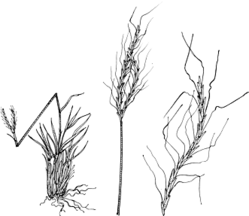Common Name: Bluegrasses

Description: Tufted perennials with usually bearded nodes.
Leaves with ligule membranous, ciliate; blade rolled in bud.
Inflorescence of digitately or subdigitately arranged racemes, bearing spikelets to the base; joints and pedicels solid, spikelet pairs falling with the adjacent axis joint.
Spikelets in pairs (terminal spikelets in triplets), 1 sessile, fertile, awned, the other pedicellate, male or sterile, unawned; basal spikelet pairs persistent, often sterile and unawned. Sessile spikelets with 1 bisexual floret, awned, callus small, shortly bearded. Lower glume 2-keeled, often with a subapical fringe of hairs and hyaline apex; the upper keeled, 3-nerved. Lemmas 2, the lower nerveless, the upper with a short base tapering into a long awn. Palea 1, minute or absent. Pedicellate spikelet awnless, reduced to 2 glumes, sometimes enclosing a lemma with or without a male flower.
Distribution and occurrence: World: c. 20 species, Old World tropical regions. Australia: 8–10 species (5–7 species native, 3 species naturalized), all States.
Text by S. W. L. Jacobs & C. A. Wall
Taxon concept:
Taxa not yet included in identification key
Dichanthium annulatum,
Dichanthium aristatum
| | Key to the species | |
| 1 | Lower glume of sessile spikelet with short hairs on the keels towards the apex; racemes 1–3, not conspicuously hairy | Dichanthium tenue |
| Lower glume of sessile spikelet with a fringe of long hairs towards the apex; racemes 1–6; usually with dense hairs | 2 |
| 2 | Sessile spikelets 5–6 mm long, pedicellate spikelets male, racemes 1–3, usually purplish | Dichanthium setosum |
| Sessile spikelets 3–4.5 long; pedicellate spikelets sterile; racemes usually 2–4, light coloured
Back to 1 | Dichanthium sericeum |
|


